最新人教版七年级上册英语unit5教案
- 格式:doc
- 大小:99.00 KB
- 文档页数:8
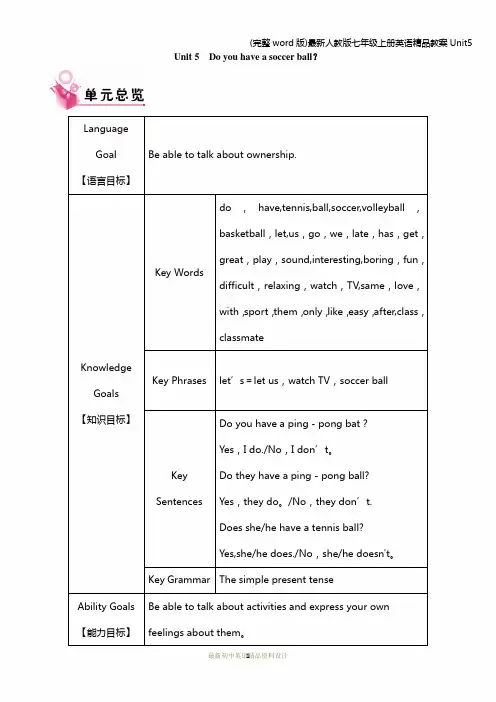
Unit 5Do you have a soccer ball?LanguageGoal【语言目标】Be able to talk about ownership.KnowledgeGoals 【知识目标】Key Wordsdo,have,tennis,ball,soccer,volleyball,basketball,let,us,go,we,late,has,get,great,play,sound,interesting,boring,fun,difficult,relaxing,watch,TV,same,love,with,sport,them,only,like,easy,after,class,classmateKey Phrases let’s=let us,watch TV,soccer ballKeySentencesDo you have a ping-pong bat?Yes,I do./No,I don’t。
Do they have a ping-pong ball?Yes,they do。
/No,they don’t.Does she/he have a tennis ball?Yes,she/he does./No,she/he doesn't。
Key Grammar The simple present tenseAbility Goals 【能力目标】Be able to talk about activities and express your own feelings about them。
Moral Goals【情感目标】Form a good habit of loving sports。
Teaching Time【课时】Four periodsPeriod 1Section A(1a-1c)Period 2Section A(2a -3c)Period 3Section B(1a-1d)Period 4Section B (2a-Shelf Check)Period 1 Section A (1a-1c)Teaching important points【教学重点】1.Key words &phrases:do,have,tennis,ball,ping-pong,bat,soccer,soccer ball,volleyball,basketball 2.Key sentences:Do you have a ping-pong bat?Yes,I do.Do you have a ping-pong ball?No,I don't。

Unit 5 Fun Clubs单元话题talk about clubs at school anddiscover your interests and talents主题范畴人与自我主题群生活与学习子主题内容多彩、个性、有意义的学校生活主题意义本单元以听力、对话和阅读等多模态形式阐述了这一主题。
学生将正确运用目标句型和恰当的情态动词,有条理地介绍不同社团的所学内容和功能、自身的能力以及想加入的社团。
通过引导学生思考自己的兴趣爱好和特长,帮助他们对各种俱乐部进行评估和抉择,从而找到与自己契合的团体,以此来丰富课余生活,发展个人技能,拓展社交圈子,并在团队中获得成长和快乐。
单元主题研读What本单元由四篇对话、一篇记叙文、一则广告三种不同类型的语篇组成。
三种语篇涉及不同的语篇知识:第一种语篇以对话方式谈论了自己想加入的俱乐部以及能做的事情;第二钟语篇以记叙文的方式介绍了朋友琳达能做的事情;第三种语篇以广告的形式呈现了俱乐部纳新,以广告的形式呈现了俱乐部成员的要求、活动内容、活动时间、活动地点以及联系方式。
Why该单元旨在培养学生本单元的主旨意义在于引导学生认识到学校生活的多彩、安全和有意义,激发他们积极参与学校活动的兴趣,了解到不同的俱乐部和活动,认识到参加这些活动的意义和价值,从而丰富自己的学校生活,提高自己的生活质量。
培养他们充实自己的课余生活,提高自己的综合素质,培养学生的选择和决策能力。
How本单元的核心语言主要围绕俱乐部、俱乐部的活动、能力介绍等方面展开。
涉及俱乐部的介绍(club, choose, drama, join),俱乐部活动(play Chinese chess, musical instrument, paint, climb, act out, nature, beef, take photos,collect, insect, discover, wildlife),描述能力(I can do sth./I can’t do sth./Can you do sth.?/What club do you want to join?)等。
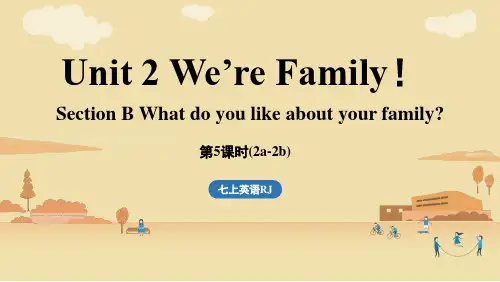
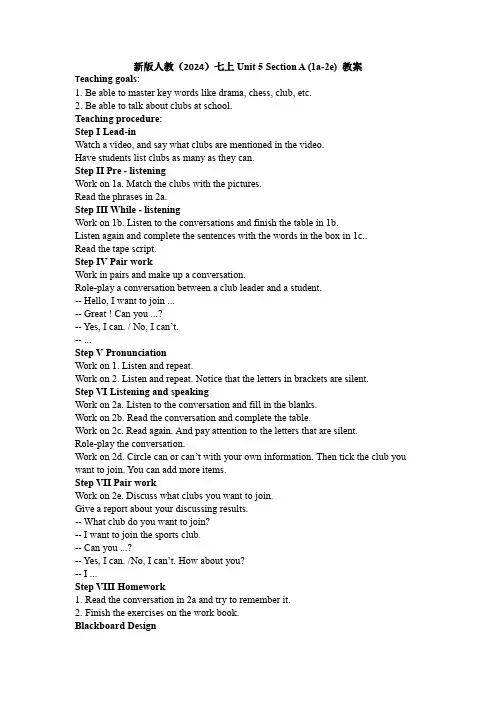
新版人教(2024)七上Unit 5 Section A (1a-2e) 教案T eaching goals:1.Be able to master key words like drama, chess, club, etc.2.Be able to talk about clubs at school.Teaching procedure:Step I Lead-inWatch a video, and say what clubs are mentioned in the video.Have students list clubs as many as they can.Step II Pre - listeningWork on 1a. Match the clubs with the pictures.Read the phrases in 2a.Step III While - listeningWork on 1b. Listen to the conversations and finish the table in 1b.Listen again and complete the sentences with the words in the box in 1c..Read the tape script.Step IV Pair workWork in pairs and make up a conversation.Role-play a conversation between a club leader and a student.-- Hello, I want to join ...-- Great ! Can you ...?-- Yes, I can. / No, I can’t.-- ...Step V PronunciationWork on 1. Listen and repeat.Work on 2. Listen and repeat. Notice that the letters in brackets are silent.Step VI Listening and speakingWork on 2a. Listen to the conversation and fill in the blanks.Work on 2b. Read the conversation and complete the table.Work on 2c. Read again. And pay attention to the letters that are silent.Role-play the conversation.Work on 2d. Circle can or can’t with your own information. Then tick the club you want to join. You can add more items.Step VII Pair workWork on 2e. Discuss what clubs you want to join.Give a report about your discussing results.-- What club do you want to join?-- I want to join the sports club.-- Can you ...?-- Yes, I can. /No, I can’t. How about you?-- I ...Step VIII Homework1.Read the conversation in 2a and try to remember it.2.Finish the exercises on the work book.Blackboard DesignHow do you choose a school club?What club do you want to join?I want to join the ...Can you ...?新版人教(2024)七上Unit 5 Section A Grammar focus教案T eaching goals:1.Be able to master key words like climb, musical, instrument, sing, etc.2.Be able to talk about abilities using can.Teaching procedure:Step I Lead-inShow some pictures and ask students the question:Can you play football/basketball/the piano/ ...What can you do?Have them talk about their abilities.Step II PresentationRead the sentences in grammar focus.Pay attention to the word “can”.Step III Group workWork in groups and talk about how to use “can”. Think and talk about the following questions:1.What’s the meanings of “can”?2.Where do we put the word “can” in the question sentences?3.How to answer to the questions with “can” in the beginning?Make a conclusion about the usage of “can”.Have students make some sentences with “can”.Step IV ExerciseWork on 3b. Match the parts to make sentences. Then make more sentences with “can”.Check the answers and read the sentences.Finish the exercises in 3c. complete the passage with the words in the box.Step V Pair workInterview your classmates and tick can or can’t. Then give a report.Step VI Homework1.Read and try to remember the sentences in the grammar focus.2.Finish exercises in this unit on the work book.Blackboard DesignWhat can you do?Can you ...?Yes, I can. / No, I can’t.What club do you want to join?I want to join the ...club.T eaching goals:1.Be able to master key words like mind, fall, nature, etc.2.Be able to find out what people do in different clubs.Teaching procedure:Step I Lead-inShow them some pictures of different clubs. And practice the following talk:-- What can you do?-- I can ...-- Can you ...?-- Yes, I can. / No, I can’t.-- What club do you want to join?-- I want to join the ... club.Step II ReadingRead the comments from some students and discuss what clubs they should join.-- I’m good at telling stories. I often act out stories with my brother at home.-- I’m interested in nature. I love hiking, and I can read maps.-- I can’t cook, but I love great food. I want to cook for my family.Read the ads. Choose a mistake club for each student in 1a and tell your reasons. Read again and complete the table in 1c.Step III Pair workWork in pairs and discuss the following questions:1.What food can you cook? What other food do you want to learn to cook?2.What can you learn from a book club?3.What do you want to be in a nature club?Complete the email with the words in the box.Read the ads again. And circle key words.Step IV Language points1.learn to do sth2.You name it.3.more than4.act out5.make friends with sb6.aall in love withStep V WritingWork on 2b. Choose one club from 2a. Write an email to the organizer and say why you’d like to join the club.Step VI Homework1.Polish your writing.2.Finish exercises in this unit on the work book.Blackboard DesignI wan to join .... I have some reasons. / Let me tell you why. First of all, ....T eaching goals:1.Be able to master key words robotics, team, contact, etc.2.Be able to know how to start your own club.Teaching procedure:Step I RevisionAsk students what club they want to join.Work on 3a. Think of a club you would like to set up in your school.Read the ad in 3a. And think about how to write an ad for a club.Step II Group workWork in groups. Interview your classmates. Find new members for your club. -- Can you work well with your hands?-- Yes, I can.-- Can you come at 12:30 p.m. on Tuesday?-- Yes, I can. / No, I can’t.Step III Show timeMake a report about your group members’ situations.Step IV ReflectingAll students finish the table according to their own situation.Step V Homework1.Read and remember the words in this unit.2.Finish exercises in this unit on the work book.Blackboard Designbe interested in / have an interest inlook forwork well with ...think up new ideas = come up with new ideaswork as a team。
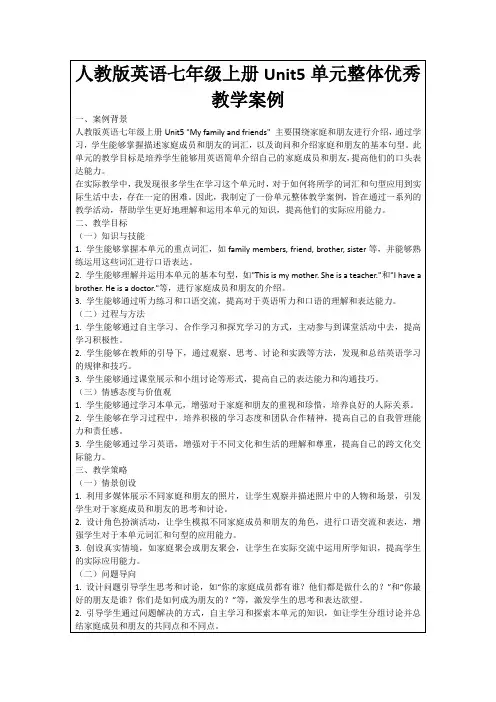
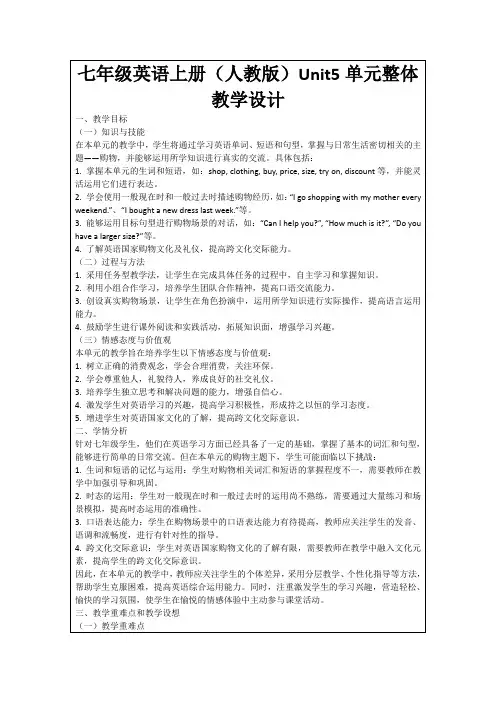
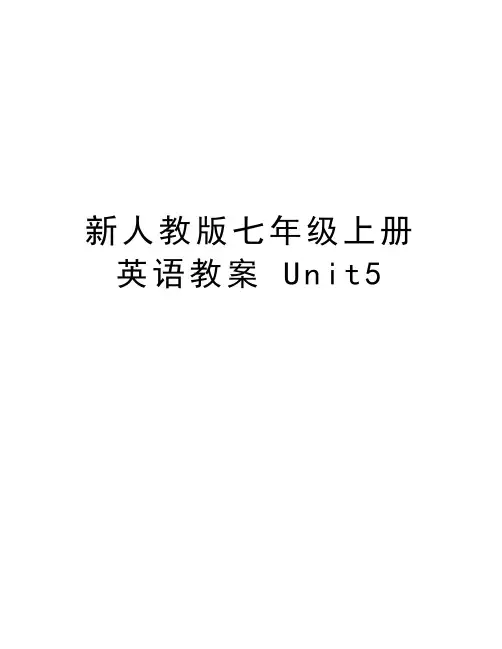
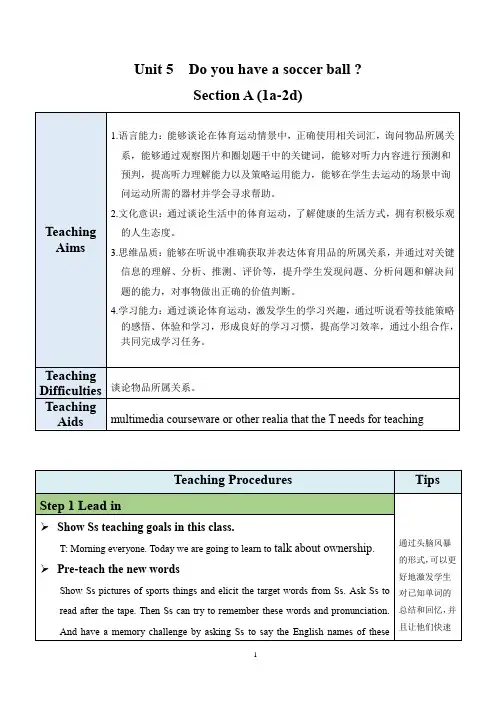
Unit 5 Do you have a soccer ball ?Section A (1a-2d)Unit 5 Do you have a soccer ball? Section A (Grammar Focus-3c)B: Yes, he does.A: Where is it?B: It's on the table.Step 4 Language Points1.great adj. 美妙的;伟大的great独立成句,常用于口语中,表示说话人的喜悦之情,通常意为“太好了”。
2.play v.参加(比赛或运动); 玩耍1) play在此处是及物动词,后接表示球类运动的名词时,play 与球类运动名词之间不加冠词。
2) play作动词还可意为“玩耍”,play with sb./sth.表示“和某人一起玩/玩……”。
3) play作动词,还可意为“演奏;弹奏”,后接表示乐器的名词时,乐器名词前要加定冠词the。
3. sound v.听起来好像sound在此处作连系动词, 也是感观动词,后常接形容词作表语。
常见的感官动词:Step 5 Exercises & HomeworkExercisesAsk Ss to do the exercises on P30-P32.Ask Ss to make a summary about language points they learned today.Homework1. Preview the new words and phrases in Section B(1a-1d).2. Do the exercises in students’ book.Teaching I didn’t do well in explaining the grammar part. Well, the third singular form of verbs was a little complicated, so the students didn't fully understand it, especially the B-level。
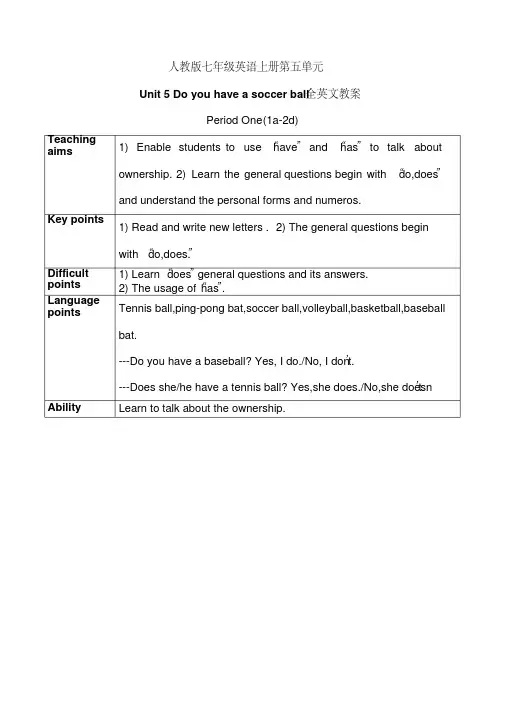
人教版七年级英语上册第五单元Unit 5 Do you have a soccer ball全英文教案Period One(1a-2d)Teachingaims 1) Enable students to use “have”and “has”to talk about ownership. 2) Learn the general questions begin with “do,does”and understand the personal forms and numeros.Key points1) Read and write new letters . 2) The general questions beginwith “do,does.”Difficult points 1) Learn “does” general questions and its answers.2) The usage of “has”.Languagepoints Tennis ball,ping-pong bat,soccer ball,volleyball,basketball,baseball bat.---Do you have a baseball? Yes, I do./No, I don’t.---Does she/he have a tennis ball? Yes,she does./No,she doesn’t. Ability Learn to talk about the ownership.Teaching procedures:Step 1 Warming-up1. Greetings.2. Review the letters and language structures the Ss have learnedin Unit Four.Step 2 Presentation1. Show the students other objects. Teach the new words “soccerin theball, ping-pong ball, volleyball, tennis bat, ping-pong bat” same way. --- What’s this/ tha t?---It’s …2. Look at the words in 1a and match the words with the things inthe picture.3. Present the key structure.Present these questions and answers.(Point to a student who has a pencil box.)T: Do you have a pencil box?S1: Yes, I do. (Nod your head yes) / No, I don’t. (Shake your headno)T: (Ask S2) Does she have a pencil box?S2: (Help S2 answer) Yes, she does. / No, she doesn't.Step 3 PracticeGet Ss to finish 1a.1b,1c,2a,2b,2c.Step 4 Presentation(Show a soccer ball to class.)T: Let’s play soccer ball after class, OK?S1: OK.T: We often use the drill “Let’s…”to make a suggestion. If youwant to do it, you may say “OK. / That sounds good. / All right …”If you don’t want to do it, you may say “No, I don’t have a …”Step 5 Role-play1. Cindy and Helen want to play baseball. Now read the conversation and match the things with their right places.2. Read the conversation after the teacher and practice the conversation with your partner.3. Ask some pairs to act out the dialogue in front of the class.Homework1. Recite the new words and conversations we have learned.2. Finish Exercise 1.BriefsummaryUnit5 Do you have a soccer ball?Period Two(3a-3c)Teachingaims 1) Get Ss to use have and has to talk about ownership freely. 2) Further learn the general questions begin with “do,does”andunderstand the personal forms and numeros.Key points1) The general questions begin with “do,does.” 2)The usage ofpersonal forms and numeros.Difficult points 1) How to enable students to understand ang grasp the usage of personal forms and numeros.Languagepoints Great, play, That sounds good.---Does Bob have a soccer ball? Yes,he does./No,he doesn’t.Ability understand and grasp the usage of personal forms and numeros skilfully.Teaching procedure:Step 1 Warming-up1.Greeting the Ss. Check their homework. (Let some Ss reporttheir parents' sports collection)2. Let the Ss work in groups (each group has three Ss). Reviewthe sentence structures we learned.Step 2. Grammar Focus.Get Ss to read the sentences in the chart and drawa conclusion about how to use “do” and “does.”Step 3 Practice1. 3a. Write each word in the correct place in the chart.2. 3b. Ss complete the conversations with their partner.3. Check the answers with the class. (Let some pairs readthe conversation).4. Ss practice the conversation with their partner then act outthe dialogue.Step 4 Game (Remembering game)T: Look! This is Bob's room. He has many things. Look at thethings in his room for three minutes. Then close your booksand ask and answer questions with your partner.Step 5 Homework1. Recite the new words and conversations we have learned.2. Finish Exercise 2.BriefsummaryUnit5 Do you have a soccer ball?Period Three(Section B 1a-2c )Teachingaims 1)Get Ss to grasp the new words andphrases:interesting,fun,relaxing,boring,difficult.2)Get Ss to understand the survey results:Who has a soccer ball?Key points1) Talk about Ss’ likes and dislikes with description words.2)GetSs to find the answer to the questions after they read the essay.Difficult points How to enable students to understand and grasp the new words and phrases.Languagepoints Interesting, difficult, easy,relaxing,boring,fun,love sports,after class,watch TV.---Let’s play……----That sounds…..Ability Develop Ss’ primary reading abilities.Enable them to find the answer to the questions.Teaching procedure:Step 1 Warming-up1. Greet the Ss. Check the homework. (Let some pairs read out their conversation. Correct the mistakes they make)2. Review the chart of pronouns. (Show the chart on the screen)3. Let Ss look at the picture in 3a. Ask some pairs ask and answer about the picture.Step 2. Presentation1. (Show the picture which a boy is doing an interesting thing on the screen.) Learn the new words, interesting2.(Show other pictures on the screen) learn the new words: boring, fun, difficult, relaxing, easy, in the same way3. (Show some activity pictures on the screen) Learn the new phrases: "watch TV", "go to the same school", "love soccer", "after class" and "play sports"4. (Show some pictures of students on the screen)Learn the new words "student", "classmate"5. Let Ss read the new words and phrases and try to remember them.6. Read the words in 1a. (Point to the five words in 1a and ask students to repeat each one.)Correct the answers.Step 3 Listening1. Next we’ll listen to a conversation. Here are two boys in the conversation. What do they want to do? Listen.(Play the recording the first time.) (For the first time, students only listen.)2. Listen again and check the words you hear in 1a. (Play the recording again.), after that, get Ss to finish 1c.3. Check the answers.Step 4 Pair work1. T: Act out the conversation in 1c in pairs. You are Paul. Your partner is Paul's friend, Jenny. Talk about the activities in 1c.2. Let some pairs act out the conversation in front of the class. Step 5 Presentation1. (T holds basketball and another student holds a soccer ball)T: I have a basketball, but I don't have a soccer ball.He has a soccer ball, but he doesn't have a basketball.2. Write the sentence structure on the blackboard.形为动词have的否定句的构成:①第一人称/第二人称/第三人称复数人称+ don't + have + 某物②第三人称单数形式+ doesn't + have + 某物e.g.I don't have a watch.She doesn't have a tennis ball.Step6 Writing1. Find the sports words in the unit. Write them in the correct column.2. Make a report to your partner first.S1: I have a soccer ball, a volleyball, two tennis balls, three ping-pong bat…I don't have a basketball, a tennis bat, a baseball bat…3. Exchange the chart with your partner. Report your partner's sports collection.S2: He has a soccer ball, a volleyball, two tennis balls, three ping-pong bats…He doesn't have a basketball, a tennis bat, a baseball bat…Step7 Reading1. Our school magazine made a survey about sports collection. This is the survey result. Read the passage a nd answer the question:Who has a soccer ball?2. Ss read the passage q uickly and find the answer to thequestion.3. Check the answer. Let some students say their answer andsay why?4. Now let's work on 2c.Who do you think says these sentences? C heck (√) F forFrank, G for Gina or W for Wang Wei.Homework1. Review the new words we learn in this part.2. Finish Exercise3.BriefsummaryUnit5 Do you have a soccer ball?Period Four(Section B 3a-self check )Teachingaims 1)Go on learning the general questions beginning with Do or Does and the answers.2)Go on learning don’t or doesn’t in the negative sentences,understand the usage of but.Key points1)Consolidate the usage of have in the negative and generalquestions.2)Develop Ss’ abilities of writing.Difficult points Guide Ss to write with have in the negative and general questions.Languagepoints Does your mom have a baseball bat? Tom has a baseball, but he doesn’t have a baseball bat.Ability Get Ss to use have or has to write a short passage in the real situation. Teaching procedure:Step 1 Warming-up1. Greet the Ss. Check the homework. (show the chart on thescreen.)2. Review the sports words in the unit. Then let some Ss reportthe sports things they have and the things they don't have.Step 2. Writing1. Let's work on 3a. This is a survey chart. You have to writesome more questions about sports equipment in the chart. Usingthe sentence structure "Do you have a…?".2. Ss write three or more questions about sports equipment.Step 3 SurveyNow exchange books with your partner. Answer his or herquestions in 3a.You can only check (√) of the answers.Step 4 Writing1. Look at the information in 3a. Write about yourself and yourpartner with but.Ss read the first two sentences a nd try to write their own sentences according to 3a.2. 指导:①but是一个转折连词,表示意思上的转折,常用来连接两个句子。
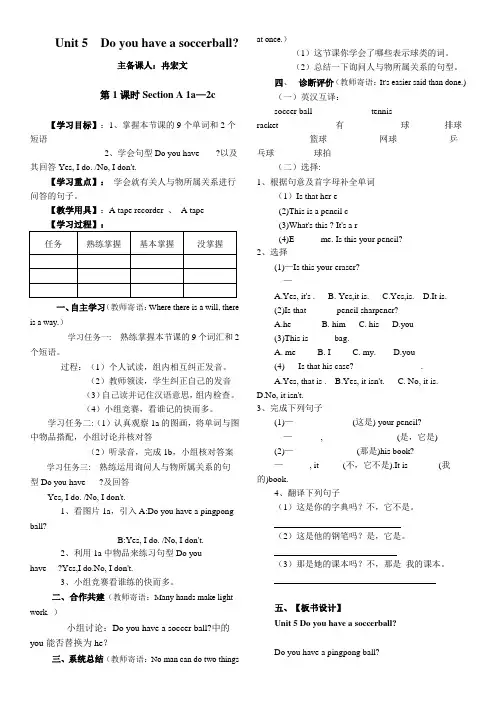
Unit 5 Do you have a soccerball?主备课人:冉宏文第1课时Section A 1a—2c【学习目标】:1、掌握本节课的9个单词和2个短语2、学会句型Do you have -----?以及其回答Yes, I do. /No, I don't.【学习重点】:学会就有关人与物所属关系进行问答的句子。
【教学用具】:A tape recorder 、A tape【学习过程】:一、自主学习(教师寄语:Where there is a will, there is a way.)学习任务一: 熟练掌握本节课的9个词汇和2个短语。
过程:(1)个人试读,组内相互纠正发音。
(2)教师领读,学生纠正自己的发音(3)自己读并记住汉语意思,组内检查。
(4)小组竞赛,看谁记的快而多。
学习任务二:(1)认真观察1a的图画,将单词与图中物品搭配,小组讨论并核对答(2)听录音,完成1b,小组核对答案学习任务三: 熟练运用询问人与物所属关系的句型Do you have ----?及回答Yes, I do. /No, I don't.1、看图片1a,引入A:Do you have a pingpong ball?B:Yes, I do. /No, I don't.2、利用1a中物品来练习句型Do youhave----?Yes,I do.No, I don't.3、小组竞赛看谁练的快而多。
二、合作共建(教师寄语:Many hands make light work. )小组讨论:Do you have a soccer ball?中的you能否替换为he?三、系统总结(教师寄语:No man can do two things at once.)(1)这节课你学会了哪些表示球类的词。
(2)总结一下询问人与物所属关系的句型。
四、诊断评价(教师寄语:It's easier said than done.)(一)英汉互译:soccer ball_____________ tennisracket_____________有_____________球________排球____________篮球____________网球____________乒乓球_________球拍_________(二)选择:1、根据句意及首字母补全单词(1)Is that her e________(2)This is a pencil c_______(3)What's this ? It's a r______(4)E______me. Is this your pencil?2、选择(1)—Is this your eraser?—__________A.Yes, it's .B. Yes,it is.C.Yes,is.D.It is.(2)Is that ______ pencil sharpener?A.heB. himC. hisD.you(3)This is _____ bag.A. meB. IC. my.D.you(4) ----Is that his case? -----__________.A.Yes, that is .B.Yes, it isn't.C. No, it is.D.No, it isn't.3、完成下列句子(1)—______ _______(这是) your pencil?—______ , ________ ________(是,它是)(2)—_______ _______(那是)his book?—______, it _____(不,它不是).It is_______(我的)book.4、翻译下列句子(1)这是你的字典吗?不,它不是。

七年级《英语》上册unit 5 教学设计(人教版)教学内容在这一单元中,学生要学会就有关人与物之间所属关系进行问答的句子。
本单元大量引入有关运动的名词,要求学生彼此询问有无此类物品,并做出相应的回答。
同时学习表示建议的句型Let’s运动的形容词。
本单元所选用的话题来自学生所喜欢的生活片段,在教学中生生交流、师生交流会更融洽,会促进师生彼此间的了解,成功的教学还会让部分学生养成良好的运动习惯和收藏习惯。
教学目标1)语言知识:A.在询问对方是否有某物的对话中学会使用do和does引导的一般疑问句;B. 学会使用描述性的形容词来评价事物;C. 学会在对话中使用名词复数;D. 学会用祈使句来向对方提出建议.2) 语言技能:A. 学会用祈使句询问某人是否有某物;B. 学会向他人提出建议的句子.3) 学习策略:A.通过与同学讨论,做出猜测;B.对所学的知识进行分类.4) 情感态度:A. 在本单元中,通过阅读有关运动的文章和对话,使学生更加热爱体育活动并培养一种适合自己的体育爱好;B.在小组活动中,培养学生团结协作精神.教学重点、难点重点:A.学会就有关人与物之间所属关系进行问答的句子;B.学习并掌握Let’s…句型.难点:A.学会使用描述性形容词对事物做出评价,如difficult/relaxing/collection/television等;B.学会使用第三人称单数的一般疑问句及回答做对话.课时安排第一课时 Section A1a-1c第二课时 Section A2a-4第三课时 Section B1a-2cPeriodOne课前准备教师:准备表格、铅笔、格尺或橡皮。
学生:调查。
教学设计Step One:Learn the new words.1. Present the key vocabulary.(Show a basketball to the class.)T: What’s this in English?S1: It’s a basketball.T: Yes,you are right. Read after me.B-A-S-K-E-T-A-B-L-L,basketball.Ss: B-A-S-K-E-T-A-B-L-L,basketball.(Show the students other objects. Teach the new words “tennisracket,ping-pong ball,volleyball,basketball”in the same way. And then showstudents the picture of television and teach it.)T: Read the words together twice.Ss: …T: Ask and answer in pairs with these things. Use the drill“What’s this in English?”and “Where is the..?”2. Look at the words in 1a and match the wordswith the things in the picture.T: Number 1 is (c ) ,tennis racket. What’s Number 2 Match them.3. Ask one student to show the answers and checkthem.Step Tw Present the structures.1. Present these questions and answers.(Point to a student who has a pen or a pencil case.)S1:Yes, I do. (Nod your head yes)T: Do you have a computer game?S1: No, I don’t. (Shake your head no)2. Practice the drill “Do you have a …?”inpairs. You can use your school things and these balls.Look at the model, thenpractice like this.Model:Sa: Do you have a backpack?Sb: Yes, I do. Do you have a soccer ball?Sa: No, I don’t. I have a volleyball.(Students work in pairs.)Step Three: Listening practice.T: Look at the four items of 1b in the pictures. Listen to theconversation.(Play the recording of 1b the first time.Students only listen.)T: Listen to the conversation and circle the words you hear.(Play the recording again.)T: Check their answers.S:…Step Four: Practice the conversations.1. Read the conversations in 1c.(Ask students to repeat.)2. Look at the picture in 1a and practice theconversation with each other in pairs.S1:Do you have…?S2:Yes, I do.S1:Do you have a …?3. Work in groups of four and use the picture topractice the similar conversations with the new words.(television,basketball,baseball bat, soccer ball, volleyball,television)T:Ask and answer the questions as many as you can.S1:Do you have a …?S2: …S1: …S2: …Step Five: Task.T: Make a survey about “What kind of balls do the students have?”We want to have a ball game. But we don’t know what kind of balls you have.Please ask your classmates in the group what balls he/ she has. Then write downthe information in the chart.1.Fill in the chart using the structure and models on the screen.Names Do you have…?Balls you have12345Structures:Do you have a …? Yes, I do./ No, I don’t.Whatballs do you have?Ihave a …Example:S1: Do you have a tennis racket, Tom?S1: What balls do you have?S2: I have basketball and football.S1: What about you?S3: …2.Choose one student from each group to report about his or hergroup. Report like this:She or he likes…One of them has a …But two ofthem have…Step Six: Homework.Make a survey about your parents’collection.Name collectionMotherfatherUnit 5 Do you have a soccer ball ?PeriodTwo课前准备教师:设计表格,准备录音机及多媒体课件。
新人教版七年级上册英语教案 Unit5Jump up if you hear a sport!" and hold up cards with different sports written on them。
Students should jump up when they hear the sport that matches the card.3.Review the vocabulary from the us unit。
including words like "book"。
"pencil"。
and "desk".II。
XXX1.Introduce XXX: tennis racket。
ping-pong ball。
soccer ball。
basketball。
and TV。
Show pictures of each item and say the name of the item.2.Model XXX:Do you have a tennis racket?Yes。
I do.Does he have a soccer ball?No。
XXX't.3.XXX.III。
n1.Ask students to work in pairs or small groups to create their own XXX descriptive adjectives to talk about the items they own.2.Select a few pairs or groups to share their ns with the class.XXX1.Review the XXX a game like "Simon Says" or "Teacher Says"。
Unit 5Why do you like pandas?单元目标第一课时Section A (1a-2d) 课时目标自主学习根据句意及音标提示写出单词及其汉语意思。
1.The pandas /'əs/ in the zoo are so cute. 熊猫2.There's a big elephant /'elɪfənt/ under the tree. 大象3.Do you like animals /'ɪmlz/? 动物4.You are really lazy /'leɪzɪ/. Get up now! 懒惰的5.I have a smart /smaː(r)t/ dog, and it is cute. 聪明的6.How beautiful /'bjuːtɪfl/ the flower is! 美丽的7.Your father is sleeping /'sliːpɪŋ/. 睡觉教学过程环节1新课导入教师向学生展示四张与动物有关的图片,然后提出下列问题,学生思考并回答。
T:What is this in the first picture?Ss:It's a panda!T:Do you like pandas?S1:Yes, I do.T:Why do you like pandas?S2:Because they are cute and smart.T:Do you like elephants/tigers/giraffes?...设计意图:通过图片吸引学生的眼球,让学生将注意力转移到课堂上;通过询问学生喜爱的动物及其原因,达到活跃课堂氛围的效果,从而自然地进入本课时的教学。
环节2学习1a-1c1.教师先让学生朗读本课时的生词,并理解词义。
2.让学生仔细观察1a中的图片,并和同桌讨论图中有哪些动物,然后将图片上的动物与左边的动物名称匹配起来。
Unit5 Do you have a soccer ball?(Section A 1a~1c)By Chen Mulan Teaching Aims:1. Have, soccer ball, tennis ball, ping pong ball, volleyball, basketball, batDo you have …?Yes, I do.No, I don’t.2. To make the students know how to ask whether others have something or notand how to answer it.3. T o develop the students’ ability of listening, speaking and reading. And makethe students love sports, love life.Key points: names of sports, d o you have …? Yes, I do. No, I don’t.Difficult points: As above and phoneticsTeaching aids: Pictures and PPTTeaching Procedure:Step 1: Warming-up1, Sing a song2. Free talkWhat’s this in English? It’s a pen/cup/dictionary.Is this yours? Yes, it is./No, it isn’t. It’s ___’s(Show your own pen) This is my pen. I have a pen. Do you have a pen?(With the help of the teacher) Yes, I do./ No, I don’t(do not)Good, and today we’ll talk about what we have.Step 2: Presentation1. Present new words (with pictures and PPT)What’s this? It’s a _____Read after me. I have a _____Do you have a _____. Yes, I do./ No, I don’t(Soccer ball, tennis ball, ping pong ball, volleyball, basketball, bat)2. Play a game. I say, you act.3. Show the pictures, have a practice.4. Match the words with the things in 1a. Now focus your attention on theword list.Step 3: Practice1.The best listenerListen and circle the words you hear. (1b)You’re great! Now please look at the four items in the list in 1b and readthem. I’ll play the record twice. Please listen carefully and circle the wordsyou hear.2. Do a pair work (1c)Now please read the conversation in 1c and practice in pairs.Step 4:SummaryLet’s read a chantStep 5: Homework1. Copy the new words in your exercise-book2. Write down at least three dialogues in your exercise-book. Blackboard design:Unit 5 Do you have a soccer ball?I have a __________________________________,_____________________。
Unit 5 Do you have a soccerball?主备课人:冉宏文第1课时Section A 1a—2c【学习目标】:1、掌握本节课的9个单词和2个短语2、学会句型Do you have -----?以及其回答Yes, I do. /No, I don't.【学习重点】:学会就有关人与物所属关系进行问答的句子。
【教学用具】:A tape recorder 、A tape【学习过程】:一、自主学习(教师寄语:Where there is a will, there is a way.)学习任务一: 熟练掌握本节课的9个词汇和2个短语。
过程:(1)个人试读,组内相互纠正发音。
(2)教师领读,学生纠正自己的发音(3)自己读并记住汉语意思,组内检查。
(4)小组竞赛,看谁记的快而多。
学习任务二:(1)认真观察1a的图画,将单词与图中物品搭配,小组讨论并核对答(2)听录音,完成1b,小组核对答案学习任务三: 熟练运用询问人与物所属关系的句型Do you have ----?及回答Yes, I do. /No, I don't.1、看图片1a,引入A:Do you have a pingpong ball?B:Yes, I do. /No, I don't.2、利用1a中物品来练习句型Do youhave----?Yes,I do.No, I don't.3、小组竞赛看谁练的快而多。
二、合作共建(教师寄语:Many hands make light work. )小组讨论:Do you have a soccer ball?中的you能否替换为he?三、系统总结(教师寄语:No man can do two things at once.)(1)这节课你学会了哪些表示球类的词。
(2)总结一下询问人与物所属关系的句型。
四、诊断评价(教师寄语:It's easier said than done.)(一)英汉互译:soccer ball_____________ tennisracket_____________有_____________球________排球____________篮球____________网球____________乒乓球_________球拍_________(二)选择:1、根据句意及首字母补全单词(1)Is that her e________(2)This is a pencil c_______(3)What's this ? It's a r______(4)E______me. Is this your pencil?2、选择(1)—Is this your eraser?—__________A.Yes, it's .B. Yes,it is.C.Yes,is.D.It is.(2)Is that ______ pencil sharpener?A.heB. himC. hisD.you(3)This is _____ bag.A. meB. IC. my.D.you(4) ----Is that his case? -----__________.A.Yes, that is .B.Yes, it isn't.C. No, it is.D.No, it isn't.3、完成下列句子(1)—______ _______(这是) your pencil?—______ , ________ ________(是,它是)(2)—_______ _______(那是)his book?—______, it _____(不,它不是).It is_______(我的)book.4、翻译下列句子(1)这是你的字典吗?不,它不是。
(2)这是他的钢笔吗?是,它是。
(3)那是她的课本吗?不,那是我的课本。
五、【板书设计】Unit 5 Do you have a soccerball?Do you have a pingpong ball?Yes, I do. /No, I don't.六、【课后反思】(教师寄语:Never do things by halves)第2课时Unit 5 Section A 3a-4 【学习目标】:1.掌握单词let,play,well,good,sport,many,club,class,more2.掌握提建议的句型Let's--【学习重点】:1.学会使用Let's---- 提建议【学习过程】:一、自主学习(教师寄语:Many hands make light work. )学习任务一: 熟练掌握本课的12个单词1.个人自读,记忆本课单词.2.小组互相检查单词读写情况.3.根据汉语写出下列英语单词并展示.让_______ 玩,打_________ 听起来____________ 运动___________大量的_________我们__________ 社团___________ 更多的____________ 班级,课________________学习任务二:完成3a的练习,根据3b练习Let's--的用法1.完成3a的练习.2.两人一组,练习下面的对话A: Let's play soccer.B: I don't have a soccer ball.A: Well, let's play volleyball.B: That sounds good.3.两人一组做替换练习二、合作共建(教师寄语:Many hands make light work. )小组讨论play+soccer,tennis,volleyball,ping-pong,sports的翻译三、系统总结(教师寄语:No man can do two things at once.)总结本单元的主要句型四、【诊断评价】(教师寄语:Never do things by halves)(一)用所给词的适当形式填空1. That _______ (sound ) good.2. ______ you _____ (have) a tennis racket?3. We have many sports _________(club).4. Let's_________(play) ping-pong.5.I _________(not have) a soccer ball.(二)选择1. ___________ you have a pen?A. doB. doesC. DoD. Does2.—Let's play ping-pong. —_____________.A. it's good.B.That interestingC.That's sound goodD. it's fun3. Do you play ________ volleyball?A. theB. aC. anD.\4. Let me ________ you.A. helpB. to helpC. for helpD. helping5. _____ Tom ________ a computer?A. Do, hasB. Does, haveC. Do haveD. Does,has6. My brother_________ have a hat.A. am notB. dontC.don'tD.doesn't(四)根据首字母完成单词1.Do you have a tennis r__________.2.In our school,we have manty s_______ clubs.3.That s_______ good.4. Let's play s_________.5. Miss Li has a c__________ game.(五)根据汉语完成句子1.我没有一个网球拍.I ______ ______ a _______ racket.2. 让我们去踢足球吧._____________________________3. 那听起来很好.That _________ good.4. 我们有很多运动俱乐部.We _______ many _______ clubs.5.你打网球吗?你踢足球吗?Do you ____________? ___________ play soccer?.五、【板书设计】Unit 5 Do you have a soccerball?play+soccer,tennis,volleyball,ping-pong,sportslet`s do sth六、【课后反思】(教师寄语:Never do things by halves)第3课时Unit 5 Section B 1a-2c【学习目标】:1.掌握单词interesting,boring,fun,difficult,relaxing,watch,watch TV2.熟练掌握提建议的句型Let's--【学习重点】:1.学会使用描述性形容词对事物做出评价如:interesting/boring/difficult/relaxing/TV等2.熟练掌握Let's--句型【教学用具】:A tape recorder 、A tape【学习过程】:一、自主学习(教师寄语:Many hands make light work. )学习任务一: 熟练掌握本课的7个单词1.个人自读,记忆本课单词.2.小组互相检查单词读写情况.3.根据汉语写出下列英语单词并展示.有趣的,令人感兴趣的______________/__________ 无聊的,令人生厌的__________困难的______________ 轻松的______________ 看电视_________________4.小组合作完成1a,从而做1b的活动.学习任务二:听录音,练习Let's--的用法1.听录音完成2a.2.再听一遍,完成2b内容.二、合作共建(教师寄语:Many hands make light work. )小组讨论play basketball能否play the basketball三、系统总结(教师寄语:No man can do two things at once.)小组讨论总结sound 为什么词?后需加什么样的词?举例说明.四、【诊断评价】(教师寄语:Never do things by halves)(一)根据句意及首字母提示补全单词1. These questions are very d_____________.2. They play football e__________ day.3. D________ she like sports?4. That s__________ interesting.5. I don't w____________ TV in the evening.6.—Let's play tennis.—No, it's b______________.7. We have manyc________:volleyball,basketball,ping-pong and more.(二)翻译短语1.打排球____________________2.玩电子游戏_________________3.看电视___________________4. 踢足球_____________________5.做运动___________________6.听起来很有趣________________7.体育俱乐部_______________ 8.那么难______________________(三)选择1.—Do Lucy and Lily have a baseball? —Yes,____________.A. she doesB. she hasC. they doD. they have2.—Let's play basketball. —No,_____________.A. it's boringB. it's interestingC. it's goodD. it's fun3.That's an ___________ question.A. interestingB. boringC. difficultD. relaxing4. Do you play _______?A. basketballsB. a basketballC. basketballD. the basketball5. Let's _____________.A. play ping-pongB.t o play ping-pongC. playing ping-pongD. play the ping-pong6. I _________ have a watch..A .am not B. dontC.don'tD.doesn't7.That sounds ___________.A. wellB. badlyC. goodD. fine(四)用所给动词的正确形式填空.1. Let's ___________ (play) soccer.2. That ___________ (sound) boring.3. He ____________ (have) a book.(五)翻译句子.1.—咱们去打篮球吧. —那听起来很有趣.—________________________________________.—________________________________.2.—你爸爸有电脑吗? —不,没有.他有个手表.—___________________________________________?—_________, _______________.___________________________.五、【板书设计】Unit 5 Do you have a soccerball?interesting/boring/difficult/relaxing/TVlet`s …It sounds…六、【课后反思】(教师寄语:Never do things by halves)第4课时Unit 5 Section B 3a—4【学习目标】:1.掌握本节课的9个单词和4个短语2.学会写某人所拥有物品的短文【学习重点】:学会写某人所拥有物品的短文【学习过程】:一、自主学习(教师寄语:Knowledge is power.)学习任务一: 会读写29页上的单词和短语过程:1.自读并记忆单词5分钟2.两人一组,相互提问3.展示交流,小组竞赛(以听写形式进行展示)单词:美妙的;大的收藏品;收集物但是只;仅仅他们(的宾格)每个天;一日复数:racket basketballvollayball三单:have watch play短语:体育收集品参加体育运动每天通过电视看---节目三个棒球学习任务二: 学习3a3b部分过程:1.学生自读3短文,圈出与体育有关的物品2.组内交流,理解短文意思3.学生展示,其他学生质问或补充,教师点拨,完成3a4.学生背诵3a短文并展示5.看3b图画,补全3b短文6.组内交流,核对答案7.展示成果学习任务三:学写某人所拥有物品的短文二、合作共建结合句子He only watches them on TV.I have three watches.你能说出watch 的用法吗?三、系统总结1. 总结一下你所学过的物品单词2.如何介绍某人所拥有的物品四、诊断评价1.根据句意及首字母提示补全单词(1) Here is a t________racket.(2) They play football e _______day.(3) I don't w _______ TV in the evening.(4) We have many c _______: vollyball, basketball, ping--pong .(5) Let's p_______ soccer.(6)Sue _________(not have) a great sports collection.(7)—Let's watch TV.—That ________(sound) fun.(8)He _______(have) a tennis racket.(9)—______she _______(have) a phone? —No, she doesn't.2.完成下列句子他不做体育运动,他只在电视上看。